On February 12th, the Sandy Hook Advisory Commission released the draft of their final report, presented to Connecticut State Governor Dannel P. Malloy. The report includes many recommendations to improve school security, including several related to locks / physical security:
 The report does not state specifically how this locking is to be accomplished, which gives schools some flexibility. But with so many options available, it can be hard for facility personnel to make that choice. I’ve spoken to quite a few people about this lately – law enforcement, fire marshals, school security consultants, facility managers and other school personnel, and each of them made a really good case for their lock function of choice. A few things they all agreed on…the lock must be lockable from within the classroom, AND must allow authorized access by staff and first responders from the ingress side, AND must allow free egress from within the classroom.
The report does not state specifically how this locking is to be accomplished, which gives schools some flexibility. But with so many options available, it can be hard for facility personnel to make that choice. I’ve spoken to quite a few people about this lately – law enforcement, fire marshals, school security consultants, facility managers and other school personnel, and each of them made a really good case for their lock function of choice. A few things they all agreed on…the lock must be lockable from within the classroom, AND must allow authorized access by staff and first responders from the ingress side, AND must allow free egress from within the classroom.
But which lock function is best for classroom doors? There are pros and cons to each:
Classroom Security Function
Pros: The outside lever can be locked from within the classroom, only by a staff member with a key. An unauthorized person will not be able to lock the classroom door if they don’t have access to the key.
Cons: Use of the key to initiate a lockdown requires the staff member to find the key, insert it in the lock, and turn it in the right direction. This can be difficult during an emergency situation, as fine motor skills may be compromised. If school staff have not repeatedly practiced locking the door with the key, they may be confused about how to lock the door or whether the door is actually locked. An indicator can help to overcome that uncertainty.
Entrance / Office Function
Pros: It is very easy to lock the outside lever, by turning a thumbturn or pushing a button on the inside lever handle of the lock.
Cons: Anyone is able to lock the door, including someone who may want to secure a classroom to commit an assault, theft, vandalism, or sexual assault. There are hundreds of thousands of these crimes committed in schools each year.
Storeroom (or Traditional Classroom Function – kept locked)
Pros: Often for budgetary reasons, existing locks may be kept in the locked position at all times. If the door is closed, the door is locked.
Cons: This can be inconvenient if the door is kept closed and students need to enter the room after class begins. In the case of classroom locks which could be left unlocked, procedures must be followed to ensure that the outside lever is always kept locked.
Pros: Pressing a button on a fob worn by staff members can be used to lock the door. This removes the concern about the fine motor skills require for inserting and turning a key, but does require staff to wear the fob. Lockdown cannot be initiated by an unauthorized person who is not in possession of the fob.
Cons: The cost of replacing existing locks with an electronic product may not be feasible for all facilities.
What other pros and cons can you think of with regard to these functions (leave a comment below)? And how about a poll…
You need to login or register to bookmark/favorite this content.





what about a combination classroom security and Entrance/Office solution. There are locks that are used for students that are unstable and need to be isolated for a time. The idea is that a momentary lock function is available so that as long as a teacher is holding the lock it is secure. When the teacher released the lock it is disabled. If a manual thumb turn with a spring action is initiated from inside the room, this can be a immediate locking of the door while the teacher takes the time needed to use the key to permanently lock the door. Then the key would also be needed to unlock the door so that a student couldn’t fall prey to the coercing of a predator to open the door and violate school policy.
This also keeps the door from being locked by a non-violent sexual predator. He would not be able to keep the door locked without the use of a key.
Thank you
That’s an interesting idea. Thanks for your comment, Bruce.
Elected government lockdown rooms use a independent dedicated deadlock. Is that not being considered to save money?
Egress codes require the door to be unlatched with on operation, so a door with a lockset and a separate deadbolt is not code-compliant for a classroom unless the jurisdiction has modified the national codes.
Thank you Lori, my classroom code knowledge is very limited. Ha!
Hang around here for a while and you’ll be an expert! 🙂
Thanks for the great list and analysis of the various options. I’ve presented most of these arguments to school administrators when we need to decide which one to pick for their project. And all but the more expensive electronic lock down have been chosen. The most important part of the whole system is teaching the participants how to use it. Locking by a credentialed person (classroom security & electronic) doesn’t work if the person is not required to have their credential with them at all times. Interior (classroom side) locks need to have a common (cross)key – not a match to the corridor side. Locks with thumb turns work but students need to know that prank locking has serious consequences. Same problem with the storeroom function.
I agree 100%!
With an interior key such as Sargent 10G38 I noticed that you need good eyes to immediately know which way to turn the key.
If you go with the interior key, be sure it’s abundantly clear which way to turn to lock.
Don’t confuse me when I’m in panic mode. Just clearly show me which way.
(in my neck of the woods I see lots of doors with black marker on the doors indicating which way to turn the key.)
Here’s an alternative to the Sharpie: https://www.etsy.com/listing/209617761/lock-directional-stickers-qty-50?ref=sr_gallery_25&ga_search_query=lock+sticker&ga_search_type=all&ga_view_type=gallery
🙂
good thing we have an in-house print shop.
those stickers are $1.00 each without shipping charges.
In a K12 building renovation here, they used Russwin ML2072 mortise locks: classroom security with deadbolt. The key inside would throw the deadbolt, but the inside lever would release the deadbolt and simultaneously, while still leaving the outside lever locked. The only problem was that there was no locked indicator, but locking was straightforward: turn the key 360, top of key towards door frame.
Here’s the problem: they weren’t installed correctly. If you turned the key 360 inside with the intent of locking the door, someone could just turn the outside lever, and it would release the deadbolt and latch simultaneously. You had to turn the key 360, then an additional 135 or so degrees until you heard a click, then back to 12 o’clock.
As is typically the case with lock installs where it “works” in some matter, there were no plans to fix this, so it went into the maintenance black hole with things like exit devices that engage the strike so little a decent tug on the outside handle opens the door.
Wow – what a shame! 🙁
– Lori